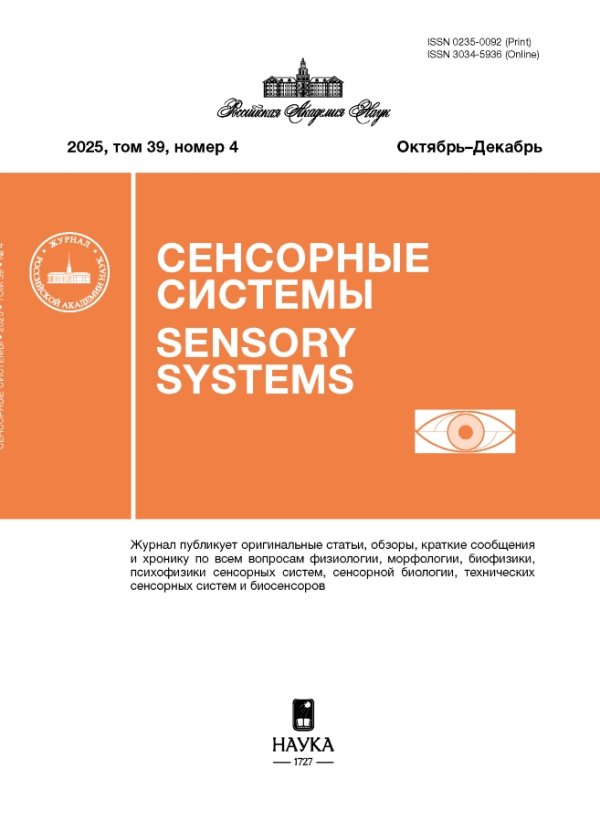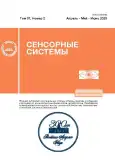The response of adult adzuki been borer Ostrinia scapulalis to light stimuli in a wind tunnel
- Authors: Zhukovskaya M.I.1, Selitskaya O.G.2, Schenikova A.V.2, Miltsyn A.A.2, Grushevaya I.V.2, Kononchuk A.G.2, Frolov A.N.2
-
Affiliations:
- I.M. Sechenov Institute of Evolutionary Physiology and Biochemistry, RAS
- All-Russian Research Institute for Plant Protection
- Issue: Vol 37, No 2 (2023)
- Pages: 130-137
- Section: ЗРИТЕЛЬНАЯ СИСТЕМА
- URL: https://journals.rcsi.science/0235-0092/article/view/138219
- DOI: https://doi.org/10.31857/S0235009223020063
- EDN: https://elibrary.ru/QTCPSV
- ID: 138219
Cite item
Full Text
Abstract
The attraction of nocturnal insects to light is a known phenomenon with unknown physiological mechanisms. Moths of the pyralid family are characterized by the most pronounced response to light, but the spectral preferences of these insects have not been studied. The adzuki been borers Ostrinia scapulalis, which live on dicotyledonous plants, are the ancestral form for the Asian and European corn borers, widespread pests of corn. Using a wind tunnel modified to deliver light stimuli, we tested the responses of males and females to light stimuli with wavelengths of 532, 440 and 365 nm at 2 lux, capable of stimulating photoreceptors of compound eyes (with maximum sensitivity of 352, 413, 480 and 530 nm) as well as simple ocelli, whose sensitivity had the main peak in ultraviolet and additional one in the green spectrum (360 and 520 nm). It turned out that ultraviolet was the most attractive stimulus. A small percentage of insects responded to green light, but showed a freezing reaction near the light source. The least attractive was blue light, which also caused freezes. Thus, the flight of O. scapulalis adults is induced by short-wavelength light, the response is more consistent with the sensitivity of the ocelli than the compound eyes; blue and green light leads to a masking effect.
About the authors
M. I. Zhukovskaya
I.M. Sechenov Institute of Evolutionary Physiology and Biochemistry, RAS
Author for correspondence.
Email: mzhukovskaya@yahoo.com
Russia, 194223, St. Petersburg, Tores ave., 44
O. G. Selitskaya
All-Russian Research Institute for Plant Protection
Email: mzhukovskaya@yahoo.com
Russia, 196608, St. Petersburg, Pushkin, Podbelskogo st., 3
A. V. Schenikova
All-Russian Research Institute for Plant Protection
Email: mzhukovskaya@yahoo.com
Russia, 196608, St. Petersburg, Pushkin, Podbelskogo st., 3
A. A. Miltsyn
All-Russian Research Institute for Plant Protection
Email: mzhukovskaya@yahoo.com
Russia, 196608, St. Petersburg, Pushkin, Podbelskogo st., 3
I. V. Grushevaya
All-Russian Research Institute for Plant Protection
Email: mzhukovskaya@yahoo.com
Russia, 196608, St. Petersburg, Pushkin, Podbelskogo st., 3
A. G. Kononchuk
All-Russian Research Institute for Plant Protection
Email: mzhukovskaya@yahoo.com
Russia, 196608, St. Petersburg, Pushkin, Podbelskogo st., 3
A. N. Frolov
All-Russian Research Institute for Plant Protection
Email: mzhukovskaya@yahoo.com
Russia, 196608, St. Petersburg, Pushkin, Podbelskogo st., 3
References
- Grushevaya I., Kononchuk A., Malysh S., Miltsyn A., Frolov A. Svetodiodnaya lovushka dlya monitoringa kukuruznogo motyl’ka Ostrinia nubilalis: rezul’taty ispytaniya v Krasnodarskom kraye [Led trap for monitoring of the еuropean corn borer, Ostrinia nubilalis: the results of trials in Krasnodar territory]. Plant Protection News [Vestnik zashchity rasteniy]. 2019. V. 102 (4). P. 49–54 (in Russian). https://doi.org/10.31993/2308-6459-2019-4-102-49-54
- Zhukovskaya M.I., Severina I.Y., Novikova E.S. Svetovoye antropogennoye zagryazneniye: deystviye na nasekomykh [Anthropogenic light pollution: Impact on insects] Biosphera [Biosphere]. 2022. V. 14 (2). P. 126–136 (in Russian). https://doi.org/10.24855/biosfera.v14i2.669
- Novikova E.S., Severina I.Y., Isavnina I.L., Zhukovskaya M.I. Down-regulation of the ultraviolet-sensitive visual pigment of the cockroach decreases the masking effect in short-wavelength illumination. Neurosci. Behav. Physiol. 2021. V. 51. P. 1002–1007. https://doi.org/10.1007/S11055-021-01158-3
- Svidersky V.L. Polet nasekomogo [Insect flight]. Moscow. Nauka Publ, 1980. P. 136. (in Russian).
- Frolov A.N. Biotaksonomicheskii analiz vrednykh vidov roda Ostrinia Hbn. [Biotaxonomic analysis of harmful species of the genus Ostrinia Hbn.] Etologiya nasekomykh [Ethology of insects] Trudy Vsesoyuznogo entomologicheskogo obshchestva. Leningrad. Nauka, 1984. P. 4–100 (in Russian).
- Frolov A.N. Upravlenie povedeniem vrednykh nasekomykh: svetovye, khimicheskie signaly i ikh sovmestnoe deistvie. [Control of the harmful insect behaviour: light, chemical signals and their combined action]. Entomologicheskoje Obozrenije. 2022. V. 101 (3). P. 453–502 (in Russian). https://doi.org/10.31857/S0367144522030017
- Frolov A.N., Grushevaya I.V., Kononchuk A.G. Sovremennye tipy lovushek dlya monitoringa cheshuekrylykh na primere kukuruznogo motyl’ka. [Modern types of traps for monitoring Lepidoptera using the example of the corn borer.] SPb Naukoemkie tekhnologii, 2021. P. 120. (in Russian).
- Shchenikova A.V., Zhukovskaya M.I., Selitskaya O.G., Grushevaya I.V., Frolov A.N. Chuvstvitel’nost’ obonyatel’noi sistemy u vidov-dvoinikov roda Ostrinia: preadaptatsiya k osvoeniyu novogo rasteniya-khozyaina? [Sensitivity of the olfactory system in twin species of the genus Ostrinia: pre-adaptation to the development of a new host plant?]. Zhurnal evolyutsionnoi biokhimii i fiziologii. [Journal of Evolutionary Biochemistry and Physiology]. 2020. V. 56 (7). P. 723-729 (in Russian). https://doi.org/10.31857/S004445292007253X
- Baker T.C., Linn C.E.Jr. Wind tunnels in pheromone research. Techniques in pheromone research. Eds Hummel H.E., Miller T.A. New York. Springer, 1984. Ch. 3. P. 75–110. https://doi.org/10.1007/978-1-4612-5220-7_3
- Belušič G., Šporar K., Meglič A. Extreme polarisation sensitivity in the retina of the corn borer moth Ostrinia. J. Exp. Biol. 2017. V. 220. № 11. P. 2047–2056. https://doi.org/10.1242/jeb.153718
- Brady D., Saviane A., Cappellozza S., Sandrelli F. The circadian clock in Lepidoptera. Front. Physiol. 2021. V. 12. https://doi.org/10.3389/fphys.2021.776826
- Cardé R.T., Hagaman T.E. Behavioral responses of the gypsy moth in a wind tunnel to air-borne enantiomers of disparlure. Environ. Entomol. 1979. V. 8. № 3. P. 475–484. https://doi.org/10.1093/ee/8.3.475
- Charlton R.E., Kanno H., Collins R.D., Cardé R.T. Influence of pheromone concentration and ambient temperature on flight of the gypsy moth, Lymantria dispar (L), in a sustained-flight wind tunnel. Physiol. Entomol. 1993. V. 18. № 4. P. 349–362. https://doi.org/10.1111/j.1365-3032.1993. tb00608.x
- Chen Q.X., Chen Y.W., Li W.L. Ultrastructural comparison of the compound eyes of the Asian corn borer Ostrinia furnacalis (Lepidoptera: Crambidae) under light/dark adaptation. Arthropod Struct. Dev. 2019. V. 53. 100901. https://doi.org/10.1016/j.asd.2019.100901
- Chiranjeevi M., Velmathi G. Phototactic behavior of yellow stemborer and rice leaf folder moths to surface mount device-light emitting diodes of various wavelengths. Int. J. Appl. Sci. 2021. V. 19. № 1. P. 1–9. https://doi.org/10.6703/IJASE.202203_19(1).005
- Colvin J., Brady J., Gibson G. Visually-guided, upwind turning behaviour of free-flying tsetse flies in odour-laden wind: a wind-tunnel study. Physiol. Entomol. 1989. V. 14. № 1. P. 31–39. https://doi.org/10.1111/j.1365-3032.1989.tb00934.x
- Eaton J.L., Tignor K.R., Holtzman G.I. Role of moth ocelli in timing flight initiation at dusk. Physiol. Entomol. 1983. V. 8. № 4. P. 371–375. https://doi.org/10.1111/j.1365-3032.1983. tb00370.x
- Frolov A.N., Bourguet D., Ponsard S. Reconsidering the taxomony of several Ostrinia species in the light of reproductive isolation: a tale for Ernst Mayr. Biol. J. Linn. Soc. 2007. V. 91. № 1. P. 49–72. https://doi.org/10.1111/j.1095-8312.2007.00779.x
- Huang Y., Tatsuki S., Kim C.G., Hoshizaki S., Yoshiyasu Y., Honda H., Ishikawa Y. Identification of sex pheromone of adzuki bean borer, Ostrinia scapulalis. J. Chem. Ecol. 1997. V. 23. № 12. P. 2791–2802. https://doi.org/10.1023/A:1022567111508
- Huang Y., Takanashi T., Hoshizaki S., Tatsuki S., Ishikawa Y. Female sex pheromone polymorphism in adzuki bean borer, Ostrinia scapulalis, is similar to that in European corn borer, O. nubilalis. J. Chem. Ecol. 2002. V. 28. № 3. P. 533–539. https://doi.org/10.1023/A:1014540011854
- Ishikawa Y., Takanashi T., Kim C.G., Hoshizaki S., Tatsuki S., Huang Y. Ostrinia spp. in Japan: their host plants and sex pheromones. Entomol. Exp. Appl. 1999. V. 91. P. 237–244. https://doi.org/10.1007/978-94-017-1890-5_30
- Isaacs R., Willis M.A., Byrne D.N. Modulation of whitefly take-off and flight orientation by wind speed and visual cues. Physiol. Entomol. 1999. V. 24. № 4. P. 311–318. https://doi.org/10.1046/j.1365-3032.00144.x
- Jakobsson J., Henze M.J., Svensson G.P., Lind O., Anderbrant O. Visual cues of oviposition sites and spectral sensitivity of Cydia strobilella L. Journal of Insect Physiology. 2017. V. 101. P. 161–168. https://doi.org/10.1016/j.jinsphys.2017.06.006
- Kawahara A.Y., Plotkin D., Hamilton C.A., Gough H., St Laurent R., Owens H.L., Homziak N.T., Barber J.R. Diel behavior in moths and butterflies: a synthesis of data illuminates the evolution of temporal activity. Org. Divers. Evol. 2018. V. 18. № 1. P. 13–27. https://doi.org/10.1007/s13127-017-0350-6
- Kelber A., Balkenius A., Warrant E.J. Scotopic colour vision in nocturnal hawkmoths. Nature. 2002. V. 419. P. 922–925. https://doi.org/10.1038/nature01065
- Kelber A., Balkenius A., Warrant E.J. Colour vision in diurnal and nocturnal hawkmoths. Integr. Comp. Biol. 2003. V. 43. P. 571–579. https://doi.org/10.1093/icb/43.4.571
- Kim K.N., Song H.S., Li C.S., Huang Q.Y., Lei C.L. Effect of several factors on the phototactic response of the oriental armyworm, Mythimna separata (Lepidoptera: Noctuidae). J. Asia Pac. Entomol. 2018. V. 21. P. 952–957. https://doi.org/10.1016/j.aspen.2018.07.010
- Miller J.R., Roelofs W.L. Sustained-flight tunnel for measuring insect responses to wind-borne sex pheromones. J. Chem. Ecol. 1978. V. 4. № 2. P. 187–198. https://doi.org/10.1007/BF00988054
- Mizunami M. Functional diversity of neural organization in insect ocellar systems. Vision Res. 1995. V. 35. № 4. P. 443–452. https://doi.org/10.1016/0042-6989(94)00192-O
- Möhl B. Sense organs and the control of flight. Insect flight. Ed. G. J. Goldsworthy. New York. CRC Press London, 1989. P. 75–97.
- Mrosovsky N. Masking: history, definitions, and measurement. Chronobiol. Int. 1999. V. 16. № 4. P. 415–429. https://doi.org/10.3109/07420529908998717
- Mutuura A., Munroe E. Taxonomy and distribution of the European corn borer and allied species: genus Ostrinia (Lepidoptera: Pyralidae). Mem. Ent. Soc. Can. 1970. V. 102. S71. P. 1–112. https://doi.org/10.4039/entm10271fv
- Pachkin A., Kremneva O., Leptyagin D., Ponomarev A., Danilov R. Light traps to study insect species diversity in soybean crops. Agronomy. 2022. V. 12. № 10. https://doi.org/10.3390/agronomy12102337
- Royer L., McNeil J.N. Effect of relative humidity conditions on responsiveness of European corn borer (Ostrinia nubilalis) males to female sex pheromone in a wind tunnel. J. Сhem. Ecol. 1993. V. 19. P. 61–69.
- Somanathan H., Borges R.M., Warrant E.J., Kelber A. Nocturnal bees learn landmark colours in starlight. Curr. Biol. 2008. V. 18. № 21. https://doi.org/10.1016/j.cub.2008.08.023
- Takanashi T., Huang Y., Takahasi K.R., Hoshizaki S., Tatsuki S., Ishikawa Y. Genetic analysis and population survey of sex pheromone variation in the adzuki bean borer moth, Ostrinia scapulalis. Biol. J. Linn. Soc. 2005. V. 84. № 1. P. 143–160. https://doi.org/10.1111/j.1095-8312.2005.00421.x
- Wakakuwa M., Stewart F., Matsumoto Y., Matsunaga S., Arikawa K. Physiological basis of phototaxis to near-infrared light in Nephotettix cincticeps. J. Comp. Physiol. A. 2014. V. 200. P. 527–536. https://doi.org/10.1007/s00359-014-0892-4
- Warrant E., Somanathan H. Colour vision in nocturnal insects. Philos. Trans. R. Soc. B: Biol. Sci. 2022. V. 377. № 1862. https://doi.org/10.1098/rstb.2021.0285
- Yang Z., Plotkin D., Landry J.F., Storer C., Kawahara A.Y. Revisiting the evolution of Ostrinia moths with phylogenomics (Pyraloidea: Crambidae: Pyraustinae). Syst. Entomol. 2021. V. 46. № 4. P. 827–838. https://doi.org/10.1111/syen.12491
- Van Kleef J., Berry R., Stange G. Directional selectivity in the simple eye of an insect. J. Neurosci. 2008. V. 28 (11). P. 2845–2855. https://doi.org/10.1523/JNEUROSCI.5556-07.2008
Supplementary files













